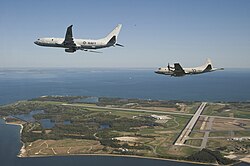| Aircraft | Unit operating | Number of aircraft | Origin |
|---|
| Combat aircraft |
|---|
| Lockheed Martin F-35A Lightning II stealth multirole fighter aircraft | No. 2 Operational Conversion Unit (RAAF Base Williamtown) No. 3 Squadron (RAAF Base Williamtown) No. 77 Squadron (RAAF Base Williamtown) No. 75 Squadron (RAAF Base Tindal) | 72 in service [1] | United States |
| Boeing F/A-18F Super Hornet strike fighter aircraft | No. 1 Squadron (RAAF Base Amberley)
| 24 | United States |
| Patrol aircraft |
|---|
| Boeing P-8A Poseidon maritime patrol and anti submarine warfare aircraft | No. 11 Squadron (RAAF Base Edinburgh) | 12 (2 on order) [2] | United States |
| AEW&C and EW aircraft |
|---|
| Boeing E-7A Wedgetail Airborne Early Warning & Control aircraft | No. 2 Squadron (RAAF Base Williamtown) | 6 [3] | Australia |
| Boeing EA-18G Growler Electronic Warfare aircraft | No. 6 Squadron (RAAF Base Amberley) | 12 [4] | United States |
| MC-55A Peregrine Intelligence, Surveillance, Reconnaissance and Electronic Warfare (ISREW) aircraft | No. 10 Squadron (RAAF Base Edinburgh) | 4 on order [5] | United States |
| Transport aircraft |
|---|
| Alenia C-27J Spartan battlefield airlifter | No. 35 Squadron (RAAF Base Amberley) | 10 | Italy |
| Lockheed C-130J Hercules medium transport | No. 37 Squadron (RAAF Base Richmond) | 12 (20 on order to replace and expand current fleet) [6] | United States |
| Boeing C-17 Globemaster heavy transport | No. 36 Squadron (RAAF Base Amberley) | 8 | United States |
| Airbus KC-30A Multi-Role Tanker Transport | No. 33 Squadron (RAAF Base Amberley) | 7 (1 VIP configured [7] ) | Spain/France |
| Boeing BBJ (Boeing Business Jet) VIP transport | No. 34 Squadron (Defence Establishment Fairbairn) | 2 | United States |
| Dassault Falcon 7X VIP transport | No. 34 Squadron (Defence Establishment Fairbairn) | 3 | France |
| Beechcraft King Air 350 light transport | No. 32 Squadron (RAAF Base East Sale) | 8 [8] [9] | United States |
| Helicopters |
|---|
| AgustaWestland AW139 SAR helicopter | RAAF Base Amberley RAAF Base East Sale RAAF Base Pearce RAAF Base Tindal RAAF Base Williamtown [10] | 6 (contracted with CHC Helicopter) [11] | Italy |
| Training aircraft |
|---|
| Diamond DA40NG | Australian Air Force Cadets | 8 (under civilian registrations) | Austria |
| Pilatus PC-21 | Central Flying School (RAAF Base East Sale) No. 2 Flying Training School (RAAF Base Pearce) No. 4 Squadron (FAC training) (RAAF Base Williamtown) | 45 [8] [12] | Switzerland |
| BAe Hawk 127 lead-in fighter trainer | No. 79 Squadron (RAAF Base Pearce)
No. 76 Squadron (RAAF Base Williamtown) | 33 | United Kingdom |
| Beechcraft King Air 350 navigation & specialised trainer | No. 32 Squadron (RAAF Base East Sale) | 4 [8] [9] | United States |
| Remotely piloted aircraft |
|---|
| MQ-4C Triton | No. 9 Squadron (RAAF Base Edinburgh) | 1 (3 on order) [13] [14] | United States |
| MQ-28 Ghost Bat | TBD | 8 (10 Block 1s and 3 Block 2s on order) [15] [16] | Australia |
|




